Digs & Discoveries
Off the Grid
By MARLEY BROWN
Monday, August 22, 2022
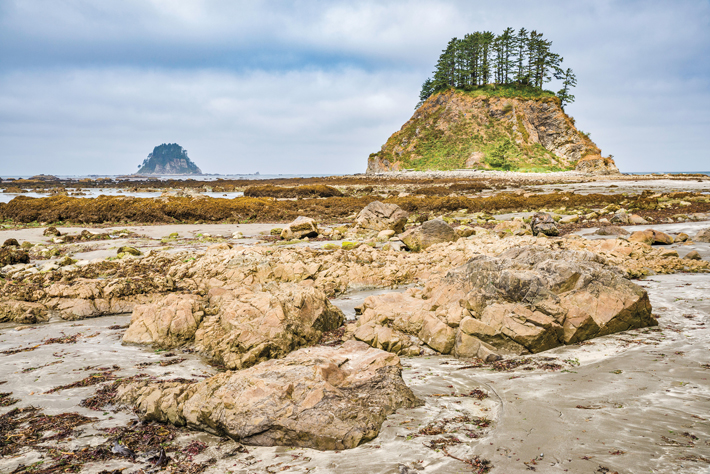
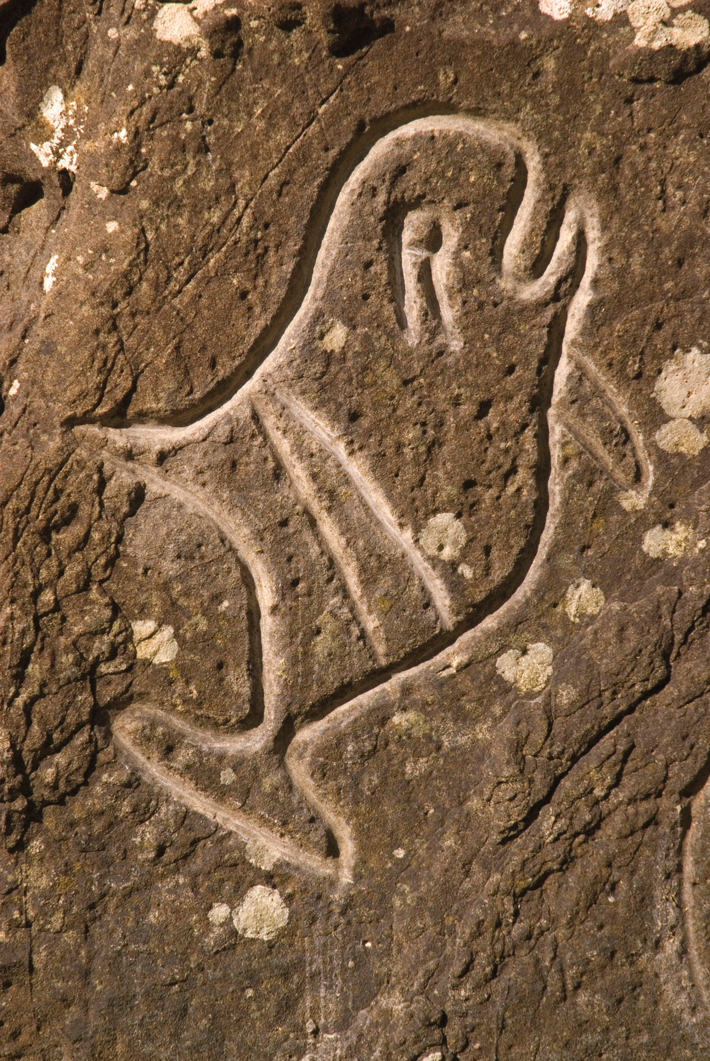 From the village of Ozette on the westernmost point of Washington’s Olympic Peninsula, members of the Makah tribe hunted whales and fished for halibut. They smoked their catch on racks and in smokehouses and traded with neighboring groups from around the Puget Sound and nearby Vancouver Island. Ozette was one of five main villages inhabited by the Makah, an Indigenous people who have been based in the region for millennia and who now mostly live about 15 miles north in Neah Bay on the peninsula’s tip. Tribal oral history and archaeological evidence suggest that, sometime between 1500 and 1700, at least a century before Makah people first came into sustained contact with Europeans, a mudslide destroyed part of the village, covering several longhouses and sealing in their contents. Thousands of artifacts that would not otherwise have survived, including baskets, cradles, clothing, and sleeping mats, as well as bows and arrows, fishhooks, clubs, and other whaling paraphernalia, were preserved under the mud.
From the village of Ozette on the westernmost point of Washington’s Olympic Peninsula, members of the Makah tribe hunted whales and fished for halibut. They smoked their catch on racks and in smokehouses and traded with neighboring groups from around the Puget Sound and nearby Vancouver Island. Ozette was one of five main villages inhabited by the Makah, an Indigenous people who have been based in the region for millennia and who now mostly live about 15 miles north in Neah Bay on the peninsula’s tip. Tribal oral history and archaeological evidence suggest that, sometime between 1500 and 1700, at least a century before Makah people first came into sustained contact with Europeans, a mudslide destroyed part of the village, covering several longhouses and sealing in their contents. Thousands of artifacts that would not otherwise have survived, including baskets, cradles, clothing, and sleeping mats, as well as bows and arrows, fishhooks, clubs, and other whaling paraphernalia, were preserved under the mud.
In 1970, a storm caused coastal erosion that revealed the remains of these longhouses and artifacts. Collaborative excavations were launched by Makah community members and Washington State University archaeologist Richard Daugherty. The excavations lasted for 11 years and unearthed more than 55,000 artifacts, hundreds of which are now on display at the Makah Museum, housed at the Makah Cultural and Research Center in Neah Bay. The center’s executive director, Janine Ledford, visited the excavations as a child and studied traditional Makah basketry, learning to make mats and replicas of harpoon sheaths for museum exhibitions. “I learned to weave an older style of beautiful, functional basketry based in part on examples found at Ozette,” says Ledford. “One outcome of the excavations was that Makah artists, including carvers and weavers, were really inspired by the artifacts that were uncovered. They have incorporated forms and styles from objects discovered at Ozette into their work.”
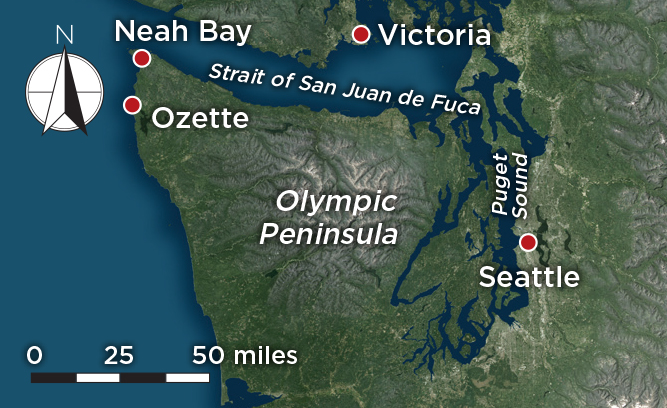 THE SITE
THE SITE
Members of the Makah tribe no longer live at Ozette, but they still visit the area to camp, hike, and fish. In 1981, after the excavations were completed, the site was filled in, and thus the archaeological remains are no longer visible. Along a picturesque four-mile hike to a remote beach, there are rocks featuring Makah petroglyphs. The artwork, Ledford says, includes designs similar to those on objects recovered from Ozette now on display at the Makah Museum in Neah Bay. One of these artifacts is a wooden model of the dorsal fin of a female killer whale inlaid with more than 700 sea otter teeth. Interpretive displays and presentations provide background on the material culture and history of the Makah people.
WHILE YOU’RE THERE
Bring your passport and cross from Port Angeles, Washington, to Victoria, British Columbia. Ferries run daily for those who want to experience the beauty of the Strait of Juan de Fuca, a passage navigated by Makah mariners for thousands of years.
Herod's Fancy Fixtures
By DANIEL WEISS
Monday, August 22, 2022
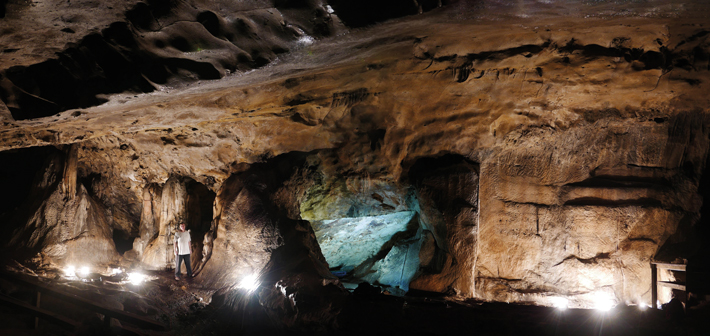 After being installed as king of Judea by the Romans, Herod the Great launched an expansive building campaign that involved constructing fortresses, palaces, and even entire cities. Herod (r. 37–4 B.C.) also installed massive bathtubs in at least two of his residences—the Kypros Fortress and the Herodium—to foster a Roman-style culture of bathing. Both tubs were made of translucent calcite alabaster and were assumed to have been imported from Egypt as no quarries producing the fine stone were known to have existed in the Levant.
After being installed as king of Judea by the Romans, Herod the Great launched an expansive building campaign that involved constructing fortresses, palaces, and even entire cities. Herod (r. 37–4 B.C.) also installed massive bathtubs in at least two of his residences—the Kypros Fortress and the Herodium—to foster a Roman-style culture of bathing. Both tubs were made of translucent calcite alabaster and were assumed to have been imported from Egypt as no quarries producing the fine stone were known to have existed in the Levant.
In recent years, however, a calcite alabaster quarry has been discovered in Te’omim Cave, on the western slopes of the Jerusalem hills, near the present-day city of Beth Shemesh. Ayala Amir, while a researcher at Bar-Ilan University, led a team that demonstrated unequivocally that the alabaster used to craft Herod’s tubs, which weigh around 3,300 pounds each, was quarried from Te’omim Cave. “We thought Herod would import materials from the best-known source—Egypt—and surprisingly, he didn’t,” says Amir. “This local quarrying industry must have been well developed, so he decided to use it instead of importing these luxurious materials from abroad.”
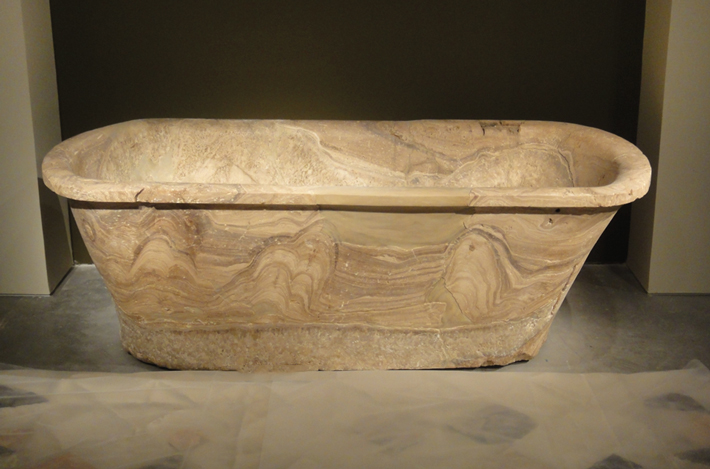
Linking the Lineages
By MARLEY BROWN
Monday, August 22, 2022
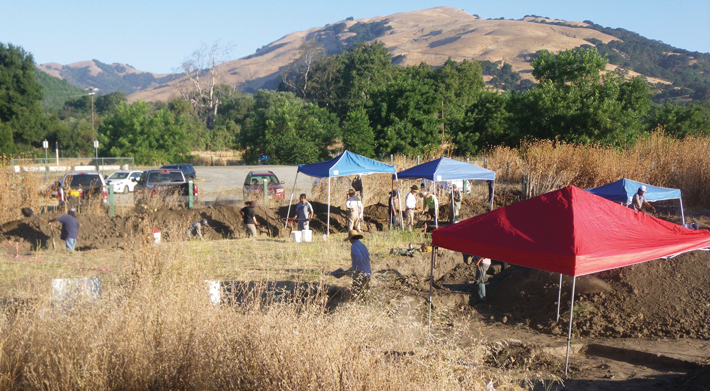 A genetic study comparing DNA from California’s Muwekma Ohlone people and DNA from remains of their ancestors supports the community’s oral history, which contends that the tribe has lived in the area for millennia. Muwekma Ohlone tribal members worked alongside archaeologists at two sites near the town of Sunol in the San Francisco Bay Area, within the group’s traditional territory. The team recovered the remains of 29 individuals at one site, which was inhabited from around 490 B.C. through 1775, and the remains of 76 people at another site, which was occupied between roughly 1345 and 1850. They sequenced the genomes of 12 of these individuals, including one who lived some 2,000 years ago.
A genetic study comparing DNA from California’s Muwekma Ohlone people and DNA from remains of their ancestors supports the community’s oral history, which contends that the tribe has lived in the area for millennia. Muwekma Ohlone tribal members worked alongside archaeologists at two sites near the town of Sunol in the San Francisco Bay Area, within the group’s traditional territory. The team recovered the remains of 29 individuals at one site, which was inhabited from around 490 B.C. through 1775, and the remains of 76 people at another site, which was occupied between roughly 1345 and 1850. They sequenced the genomes of 12 of these individuals, including one who lived some 2,000 years ago.
“We identified a genetic signature connecting the two sites and then compared that signature to present-day Muwekma Ohlone community members, whose ancestors underwent a harsh colonial process, including forced movements, missionization, and strict social control,” says genetic anthropologist Ripan Malhi of the University of Illinois Urbana-Champaign. “The genetic signature identified in the remains of Muwekma Ohlone ancestors was found in contemporary Muwekma Ohlone community members in high frequency and shows that the community has been in the region for at least 2,000 years.” For more, see “Letter From the Bay Area: California’s Coastal Homelands” (May/June 2022).
The Avars Advance
By SARA TOTH STUB
Monday, August 22, 2022
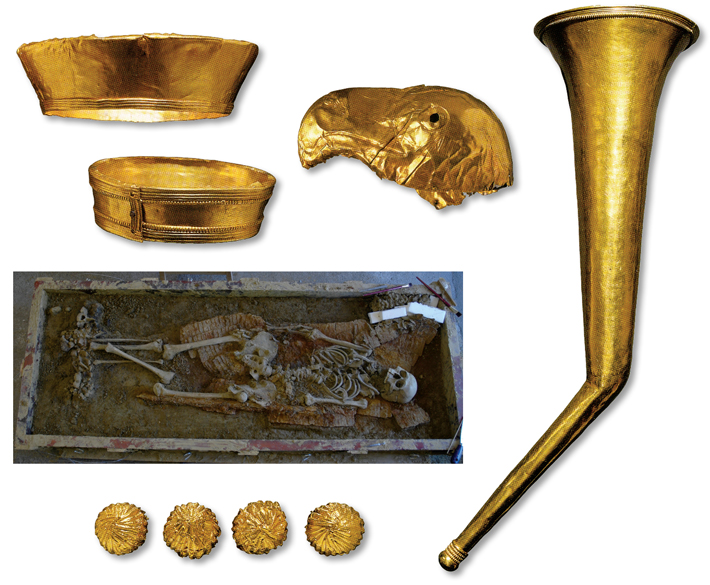 Beginning in Late Antiquity, around the sixth century A.D., a powerful group of nomads known as the Avars ruled much of Europe—and nearly conquered Constantinople. The Avars were based in the Carpathian Basin at the height of their grip on the region—from the sixth through ninth centuries A.D.—but where they came from has been a mystery. They left no written records, and scholars believe they were probably not literate. Some contemporaneous Byzantine sources portray the Avars as a menace who suddenly appeared in Europe from somewhere to the east. Archaeological discoveries, including weapons and harnesses, at Avar sites in modern-day Hungary are similar to those found on the steppes of eastern Eurasia.
Beginning in Late Antiquity, around the sixth century A.D., a powerful group of nomads known as the Avars ruled much of Europe—and nearly conquered Constantinople. The Avars were based in the Carpathian Basin at the height of their grip on the region—from the sixth through ninth centuries A.D.—but where they came from has been a mystery. They left no written records, and scholars believe they were probably not literate. Some contemporaneous Byzantine sources portray the Avars as a menace who suddenly appeared in Europe from somewhere to the east. Archaeological discoveries, including weapons and harnesses, at Avar sites in modern-day Hungary are similar to those found on the steppes of eastern Eurasia.
Analysis of DNA extracted from the remains of 66 Avars found in Hungary has provided evidence that they originated in what is now Mongolia and migrated to Hungary, a distance of more than 3,000 miles, over a single decade. “The Avars are the longest-lasting of the steppe empires in this region, longer than the more well-known Huns or Mongols, yet they are poorly understood,” says Patrick J. Geary, professor emeritus of history at Princeton University’s Institute for Advanced Study. “Our next step is to better understand the extent to which this elite group integrated with the local population.”
Pictish Pictograms
By JASON URBANUS
Monday, August 22, 2022
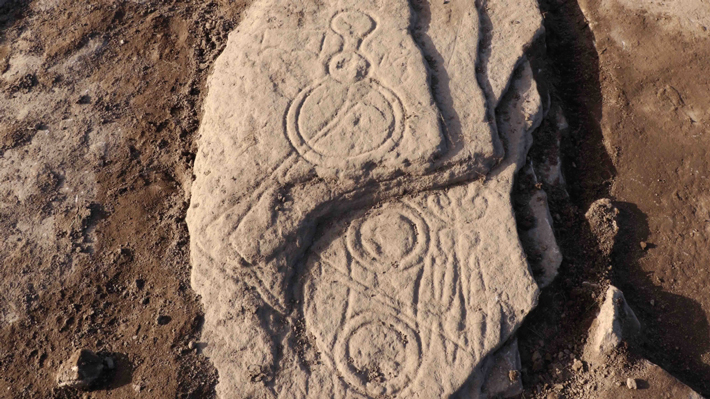 A rare carved Pictish stone was unearthed near the village of Aberlemno in eastern Scotland. The 5.5-foot-tall monument, which dates to the fifth or sixth century A.D., is covered with geometric symbols such as disks, ovals, and crescents. “The Picts appear to have created a communication system that is unique and as yet undecipherable,” says University of Aberdeen archaeologist Gordon Noble. “Our best bet is that this was a form of identity marking, perhaps communicating a person’s name or status.” The stone was reused as a paving slab in an eleventh- or twelfth-century structure that was built directly atop an ancient Pictish settlement.
A rare carved Pictish stone was unearthed near the village of Aberlemno in eastern Scotland. The 5.5-foot-tall monument, which dates to the fifth or sixth century A.D., is covered with geometric symbols such as disks, ovals, and crescents. “The Picts appear to have created a communication system that is unique and as yet undecipherable,” says University of Aberdeen archaeologist Gordon Noble. “Our best bet is that this was a form of identity marking, perhaps communicating a person’s name or status.” The stone was reused as a paving slab in an eleventh- or twelfth-century structure that was built directly atop an ancient Pictish settlement.
The region of Angus, where the discovery was made, was an important landscape for the Picts in the early Middle Ages, and several other carved monoliths have been recovered there. The pivotal Battle of Nechtansmere is believed to have been fought nearby in A.D. 685. During the battle, the Pictish king Bridei Mac Bili III defeated an army of invading Anglo-Saxons. His victory helped pave the way for the creation of the Kingdom of Scotland some 160 years later.
Advertisement
Advertisement
IN THIS ISSUE
Digs & Discoveries
The Case of Tut's Missing Collar
Alpine Crystal Hunters
Don't Give an Inch
Australia's Blue Period
Romans Go Dutch
Surveying Samnium
Heart of the Matter
Mexican Star Power
Pictish Pictograms
Linking the Lineages
The Avars Advance
Herod's Fancy Fixtures
Off the Grid
Around the World
A pregnant tortoise, sunken Spanish cargo, Maya orthodontics, Mongol summer plans, and the first fruit farmers
Artifact
A memento left along the way
Advertisement

Recent Issues
-
 May/June 2024
May/June 2024
-
 March/April 2024
March/April 2024
-
 January/February 2024
January/February 2024
-
 November/December 2023
November/December 2023
-
 September/October 2023
September/October 2023
-
 July/August 2023
July/August 2023
-
 May/June 2023
May/June 2023
-
 March/April 2023
March/April 2023
-
 January/February 2023
January/February 2023
-
 November/December 2022
November/December 2022
-
 September/October 2022
September/October 2022
-
 July/August 2022
July/August 2022
-
 May/June 2022
May/June 2022
-
 March/April 2022
March/April 2022
-
 January/February 2022
January/February 2022
-
 November/December 2021
November/December 2021
-
 September/October 2021
September/October 2021
-
 July/August 2021
July/August 2021
-
 May/June 2021
May/June 2021
-
 March/April 2021
March/April 2021
-
 January/February 2021
January/February 2021
-
 November/December 2020
November/December 2020
-
 September/October 2020
September/October 2020
-
 July/August 2020
July/August 2020
-
 May/June 2020
May/June 2020
-
 March/April 2020
March/April 2020
-
 January/February 2020
January/February 2020
-
 November/December 2019
November/December 2019
-
 September/October 2019
September/October 2019
-
 July/August 2019
July/August 2019
-
 May/June 2019
May/June 2019
-
 March/April 2019
March/April 2019
-
 January/February 2019
January/February 2019
-
 November/December 2018
November/December 2018
-
 September/October 2018
September/October 2018
-
 July/August 2018
July/August 2018
-
 May/June 2018
May/June 2018
-
 March/April 2018
March/April 2018
-
 January/February 2018
January/February 2018
-
 November/December 2017
November/December 2017
-
 September/October 2017
September/October 2017
-
 July/August 2017
July/August 2017
-
 May/June 2017
May/June 2017
-
 March/April 2017
March/April 2017
-
 January/February 2017
January/February 2017
-
 November/December 2016
November/December 2016
-
 September/October 2016
September/October 2016
-
 July/August 2016
July/August 2016
-
 May/June 2016
May/June 2016
-
 March/April 2016
March/April 2016
-
 January/February 2016
January/February 2016
-
 November/December 2015
November/December 2015
-
 September/October 2015
September/October 2015
-
 July/August 2015
July/August 2015
-
 May/June 2015
May/June 2015
-
 March/April 2015
March/April 2015
-
 January/February 2015
January/February 2015
-
 November/December 2014
November/December 2014
-
 September/October 2014
September/October 2014
-
 July/August 2014
July/August 2014
-
 May/June 2014
May/June 2014
-
 March/April 2014
March/April 2014
-
 January/February 2014
January/February 2014
-
 November/December 2013
November/December 2013
-
 September/October 2013
September/October 2013
-
 July/August 2013
July/August 2013
-
 May/June 2013
May/June 2013
-
 March/April 2013
March/April 2013
-
 January/February 2013
January/February 2013
-
 November/December 2012
November/December 2012
-
 September/October 2012
September/October 2012
-
 July/August 2012
July/August 2012
-
 May/June 2012
May/June 2012
-
 March/April 2012
March/April 2012
-
 January/February 2012
January/February 2012
-
 November/December 2011
November/December 2011
-
 September/October 2011
September/October 2011
-
 July/August 2011
July/August 2011
-
 May/June 2011
May/June 2011
-
 March/April 2011
March/April 2011
-
 January/February 2011
January/February 2011
Advertisement






